“Tess” – Mystical Feminity
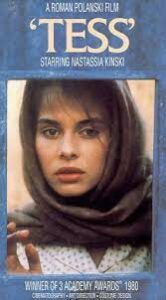
Title: “Tess”
Release Date: 1979
Director: Roman Polański
Cast: Nastassja Kinski, Peter Firth, Leigh Lawson and others
Roman Polanski dedicated „Tess” to his tragically deceased wife, Sharon Tate, who gave him Thomas Hardy’s novel shortly before her death. However, in the hands of the Polish director, the story of a sensitive girl mercilessly hurt by a cruel world becomes not only an encrypted autobiographical message, but above all a true cinematic masterpiece. It is a story about female enslavement by the body—desired, exploited, giving birth, and suffering—which, regardless of era or ideology, always remains a biological determinant of fate. It is also a film about the metaphysical dream, as Tess says, of “letting the soul rest.”
Polanski shot “Tess” in 1979. At the time, the Polish director was already the subject of much controversy. A decade earlier, his wife, Sharon Tate, had been brutally murdered by Charles Manson’s cult. In 1978, Polanski fled the United States after being accused of raping a 13-year-old girl.
The widely recognized director, unfortunately also due to his infamous deeds, was unable to shoot the film where he should have: in Great Britain (because Thomas Hardy’s novel is set in southern England), as he would have faced deportation to the US. For this reason, the film was shot in France, in Brittany. However, it must be admitted that the choice of locations did not harm the work; on the contrary, visually, the whole is a perfectly composed fresco reminiscent of 19th-century painting.
“Tess” – wounded innocence
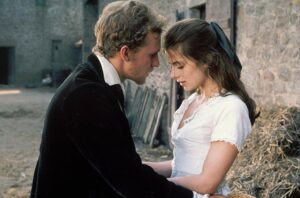
It is in the 19th century that the action of “Tess” takes place. The main character, wonderfully portrayed by the phenomenal Nastassja Kinski, comes from a poor family with many children. One day, Tess’s father learns from the pastor that her ancestors came from the powerful medieval d’Urberville family. This discovery completely changes the fate of the sixteen-year-old girl. Tess’s parents come up with the idea of sending her to a wealthy lady of the same name who lives nearby, so that the girl can ask for support for her poor relatives. Mrs. d’Urberville does not feel responsible for any of her relatives, as she bought the title herself to enhance her wealth.
However, the respectable lady’s son, Alexander (Leigh Lawson), harbors evil intentions and immediately decides to hire Tess to look after his poultry. He soon rapes the girl and then, forcing her to be grateful for helping her family, persuades her to become his mistress. However, the young servant girl cannot bear her shame and decides to return to her village without informing her admirer that she is pregnant.
When her baby dies after a few months, Tess leaves home again and finds employment in Mr. Crick’s barn. Unexpectedly, she finds true love in her new place. She marries the wealthy son of a pastor, Angel (Peter Firth). However, on their wedding night, Tess tells her husband her tragic story, and he abandons her and leaves for Brazil. The heartbroken girl humbly waits for Angel’s forgiveness and sends him letters full of declarations of love.
She falls into extreme poverty, taking on the hardest physical work. When Tess’s father dies and her mother is thrown out of the house with a bunch of small children, the resigned heroine decides to accept help from Alexander, who reappears in her life. The girl becomes his mistress. After some time, however, Angel returns, finds his wife, and, aware of his guilt, begs her for forgiveness. Tess, in a fit of rage, kills Alexander and flees with her beloved husband. After several days of wandering, however, they are captured at Stonehenge. Convicted of murder, the heroine dies on the gallows.

The movie “Tess” – mastery of film narrative and imagery
“Tess” is a film that rightly won three Oscars in the categories of Best Art Direction, Best Costume Design, and Best Cinematography. The movie is certainly one of the visual masterpieces constructed with great attention to the smallest details. Polanski has succeeded in recreating the atmosphere of the era by depicting everyday life in the 19th century. Although rich in metaphorical meaning, the film does not shy away from showing agricultural work in barns, fields, and farms with precision. What is more, it is these scenes depicting everyday toil that give the film its unique rhythm. The film’s narrative moves forward without any fireworks or sudden twists and turns, reflecting the monotonous course of human existence.
The landscape photography, clearly styled after 19th-century painting, plays a special role in Tess. Its authors are Geoffrey Unsworth (who died during the making of the film) and Ghislain Cloquet. We see pastel colors and landscapes emerging from the fog, as in the work of John Constable. We also see the painter’s characteristic attention to detail in his portrayal of rural life. In many scenes, especially at the beginning and end of the film, the characters seem to blend into the landscape, becoming part of the “picturesqueness” so characteristic of British art of that period.
In turn, in the extremely romantic sequence of a village party, during which Tess meets Angel for the first time, we can see inspiration from the work of Polish painters: Jacek Malczewski and Henryk Siemiradzki. Girls in white dresses and flowers bring to mind the Rusałka series and the portrayal of Slavic rituals accompanying Midsummer Night.
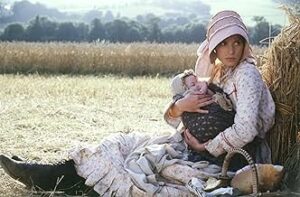
“Tess” and the burden of the female body
The film “Tess”, despite telling a tragic and moving story, avoids unnecessary pathos that could turn it into a melodrama from a bygone era. The narrative is very skillful, emphasizing the universal aspects of the story. Although it is set in the 19th century, the focus is on the portrait of an extremely sensitive young woman for whom her own gender becomes the greatest burden and, in a sense, the cause of her misfortune.
Tess’s “fault” is that she is beautiful and arouses male desire. Contrary to the cultural myth of the good, poor girl who is saved from poverty by marriage to a prince, the heroine’s beauty does not bring her happiness. On the contrary, Tess is seduced and abused by a corrupt man, which casts a shadow over her entire future life. The heroine’s body becomes the cause of her misfortune, and she then suffers the severe consequences of male domination: against her will, Tess becomes a mother. Although the girl is deeply religious, she is rejected by the community because of this, and when her child dies, the pastor refuses to bury him in consecrated ground.
The extent to which Teresa feels the weight of her misfortune is well illustrated by the scene in which she states that the greatest rest is when she lies on her back on a starry night, watching the sky. When you do this for long enough, your soul ceases to feel the burden of your body and you get the impression that you are part of the vast cosmos. It is these words, spoken casually during a meal with Mr. Crick’s employees, that catch the attention of Angel, who falls madly in love with her.
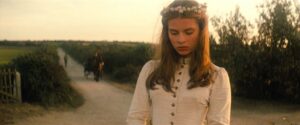
What is more, these words echo in the film’s finale, when Tess, exhausted from her escape, lies down on the stones of Stonehenge and asks her husband to let their souls rest while gazing at the sky. The girl’s metaphysical longing, her strong desire to be freed from her body, emphasize in a special way that this is about the female body and that it determines a woman’s fate to a much greater extent than the male body influences a man’s fate. Without a woman’s will, the body exposes her to suffering – becoming the object of rape or unwanted motherhood.
“Tess” by Polański – mystical femininity
The juxtaposition of the opening and closing scenes of the film is particularly striking in this context. In the first sequences, we see Tess in a white dress, with flowers in her hair, dancing joyfully in a meadow. She brings to mind a Celtic priestess or goddess of spring – the symbolism of these shots certainly refers to innocence and spirituality. What is more, this is a clear reference to the subtitle of the book on which the film is based: “a tale of a pure woman.” This purity has an almost mystical dimension here, unrelated to any specific religion, yet directly referring to a transcendent reality. Of course, Polanski implicitly evokes the biblical story of Eve’s fall. This is particularly evident in the erotically charged scene when Tess, encouraged by Alexander, eats a strawberry – the forbidden fruit – from his hand.
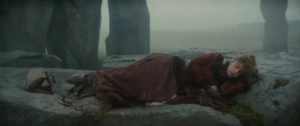
In the final shots of the movie, Tess appears in a completely different light: she is wearing a red dress and her hair is not loose but intricately pinned up. The red color, the fashionable outfit, and the hairstyle are signs of experience and being bound by convention, of learning the cruel rules of life, and also refer to the stigma of guilt. However, there is a common spiritual symbolism here, which seems to maintain a certain continuity: Tess undergoes, as it were, successive stages of mystical initiation: from an innocent novice to a victim consciously offering her body on the altar of the sun god.
A “holy sinner” and at the same time a toy in the hands of irresponsible men, she will suffer punishment not for her own sins. And although Angel finally realizes the immensity of his own stupidity and tries unsuccessfully to save his beloved, his realization comes “too late,” as Tess tells him. Because sometimes it is simply too late.
Literature:
A. Garbicz, Cinema, a magical vehicle. A guide to the achievements of feature films. Journey Five 1974–1981, Krakow 2009.
